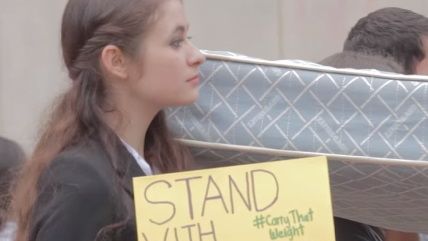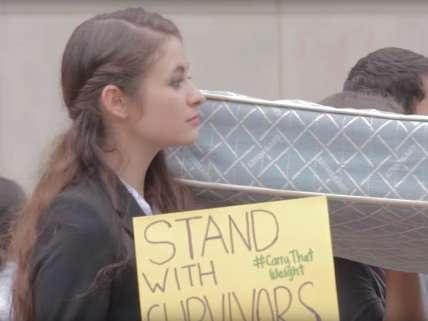Journalists Are Condemning Flawed Campus Rape Science. Will Activists Do The Same?
New York Magazine weighs in on Reason's David Lisak series.


A mainstream news outlet has taken notice of Reason's investigative work on the misleading science undergirding The Hunting Ground, a work of anti-rape advocacy that greatly mischaracterizes the nature of sexual assault on college campuses. In a brilliant article titled "The Hunting Ground Uses a Striking Statistic About Campus Rape That's Almost Certainly False," New York Magazine's Jesse Singal accuses Lisak of peddling "questionable research" that "leads people astray."
Singal draws on Reason's reporting to make his case:
Here's the short version: Miller and Lisak's data are drawn from surveys conducted of 1,882 men at UMass-Boston, a commuter school with no campus housing in which the men were asked if they had ever raped someone or attempted to rape someone. This was not a group of traditional undergraduates — the average age of those surveyed was 26.5, with the range running from 18 all the way to 71. "More than 20% were over age 30, and nearly 8% were over 40," the authors noted. Most of these men probably weren't full-time students, since UMass-Boston is largely oriented toward part-timers. Moreover, as Robby Soave ofReason reported in July, it's not even clear that all of the men surveyed were even students at all. Lisak and Miller didn't collect their own data, but rather adapted data that had been previously collected by other researchers for other purposes over a number of years prior to the publication of their paper. These researchers had handed out surveys at "main pedestrian traffic points on campus" at UMass-Boston (respondents who filled out a survey got a few bucks for their efforts) but, according to Soave's reporting, never checked whether the respondents were actually students, because for the purposes of the data they were collecting it didn't matter.
Setting aside the fact that it's unclear how many non-students were surveyed, it's also hard, from the point of view of understanding campus rapists, to even interpret the rapes that were reported, given UMass-Boston's lack of campus housing and campus social life like the sort found at more traditional schools. If a 29-year-old part-time commuter student says that, yes, in his life he has raped someone, that obviously doesn't make the rape itself any less egregious, but it's difficult to assess whether the rape can be seen as connected to his life as a college student at all. It would be a stretch, in other words, to describe him as a "college" or "campus" rapist without knowing more. The authors themselves certainly seemed to understand that: "There is not a single statement in the paper about assaults taking place on or near a campus; there is not a single reference to the campus environment," wrote Linda M. LeFauve, who hasalso raised important questions about Lisak's research in Reason.
Ultimately, Singal reaches many of the same conclusions as LeFauve and I:
In short, Lisak and Miller's study has very little to do with the conversation about sexual assault The Hunting Ground is concerned with. The respondents were older, differed in meaningful ways from "traditional" college students, and may well have been mostly reporting rapes that had nothing to do with college anyway. From a research perspective, it's often dangerous to extrapolate the results of a single survey to a broader population; in this case, to say the UMass-Boston numbers can be applied to college students on the whole is quite irresponsible, especially in light of the lack of other published findings that back up Lisak's serial-predator theory. "I am not familiar with any research that corroborates or replicates David Lisak's findings," Christopher Krebs, a well-known sexual-assault researcher at RTI international, said in an email.
And yet this baseless statistic caught on, spread like wildfire, and has been cited not just by the White House and the producers of The Hunting Ground, but by countless other activists and academics as well. As Yoffehas pointed out, Lisak has contributed to the misunderstanding by propagating the notion that his research can be extrapolated to the broader college population, despite the fact that he and Miller explicitly cautioned that their research "cannot be interpreted as estimates of the prevalence of sexual and other acts of violence" on a campus or anywhere else because of the lack of a random sampling procedure. (Lisak downplayed this caveat to Yoffe as "a standard disclaimer for any study.")
It's terrific that someone with Singal's platform has caught on to Lisak's serial exaggerations. I have complained previously that few of Lisak's defenders seem willing to address the undeniable shortcomings with his research. As far as I can tell, Lisak himself has only engaged Reason indirectly, as part of his criticism of a study that undermines his theory. But the more writers who question his credibility, the more likely it has that he will have to respond.
The anti-rape activist community, as well as higher education policy makers—including members of the White House—must also reckon with the fact that they uncritically promoted Lisak and his theories; they turned him into the patron saint of rape prevention strategies. As The Huffington Post's Tyler Kingkade wrote on Twitter, "I saw Lisak treated like a celeb at conferences."
It's long past time to reconsider Lisak's status. The makers of The Hunting Ground haven't expressed any interest in correcting their myriad errors thus far, but it's not too late for the broader activist movement to prove it consists of people who care more about reducing rape than defending fabulists.
Read Reason's series on Lisak here, here, here, here, and here.
Show Comments (124)